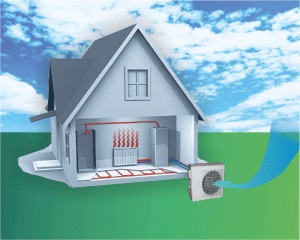The process of operation of a heat pump can be imagined by the example of the reverse cycle of the cooling device. The heat pump (hereinafter referred to as TH) takes heat from a certain part of the space (for example, from air located from the outside of the room) and increases its temperature due to the compressor in which the heat carrier is compressed. Next comes the supply of heat with high potential in the room.
In 2016, the Verkhovna Rada of Ukraine approved amendments to the Law “On alternative energy sources”. According to the updated document, TN began to refer to devices that use renewable energy. Parliamentarians ranked as renewable energy sources of earth, water and air.
 There is one outstanding feature in the operation of HP – its efficiency increases with increasing difference in temperature indicators of the source of thermal energy and the consumer of heat in the finished form. Heat pumps are used in heating systems with low temperatures. The efficiency of the pump is higher, provided that the temperature of the coolant is 35-55 degrees Celsius.
There is one outstanding feature in the operation of HP – its efficiency increases with increasing difference in temperature indicators of the source of thermal energy and the consumer of heat in the finished form. Heat pumps are used in heating systems with low temperatures. The efficiency of the pump is higher, provided that the temperature of the coolant is 35-55 degrees Celsius.
It should be noted that TN has the ability to take thermal energy from various sources – water, earth, air. When the room requires a decrease in temperature in the hot season, the opposite process starts. During cooling, the heat flux is directed back and gets into the air, land or water. A reversible pump is capable of working universally, that is, in the winter to heat the room, and in the summer to cool it.
In low-temperature heating systems do not use radiators. Most of all, surface heating systems (under floor heating, warm plinth, etc.) are suitable for successful space heating in these conditions. In addition, in a tandem with a heat pump, air heating systems with fan coils proved to be excellent.
In questions of TI productivity, there is the concept of “conversion coefficient” When heat pumps were just beginning to be introduced into real work, engineers around the world were racing to create a device with a high coefficient. This indicator clearly indicates the amount of energy consumed by the pump and the amount of heat generated. If the TH conversion coefficient is 4, then this means that the device produces 4 times more heat than it absorbs electricity for full-fledged operation.
 It should be noted the following pattern in the operation of heat pumps – the more heated the water that is used as a coolant, the lower the pump productivity. At the same time, the higher the temperature indicator has a heat source, the higher the productivity. For example, if the temperature of the heat source rises from -20 to +7 degrees Celsius, then the conversion rate of the heat pump rises from 2 to 4.
It should be noted the following pattern in the operation of heat pumps – the more heated the water that is used as a coolant, the lower the pump productivity. At the same time, the higher the temperature indicator has a heat source, the higher the productivity. For example, if the temperature of the heat source rises from -20 to +7 degrees Celsius, then the conversion rate of the heat pump rises from 2 to 4.
The following types of TN are distinguished depending on the heat production environment:
– soil (receives thermal energy from the earth);
– water (receives energy from open reservoirs or underground water horizons);
– air (gets heat from the air).
An air heat pump takes energy from the external environment (air), therefore its productivity is closely related to the ambient temperature. If the outside temperature is too low, the efficiency of the pump decreases and its use becomes irrational. The low temperature of the coolant at the inlet makes it impossible to heat the water to the required level with minimal energy consumption. The same thing happens when the room is cooled in conditions of too high temperature outside. For each pump, there is a range of optimum temperatures set by the manufacturer. When installing such equipment, you should pay attention to this item and compare it with the temperature conditions of your region.


